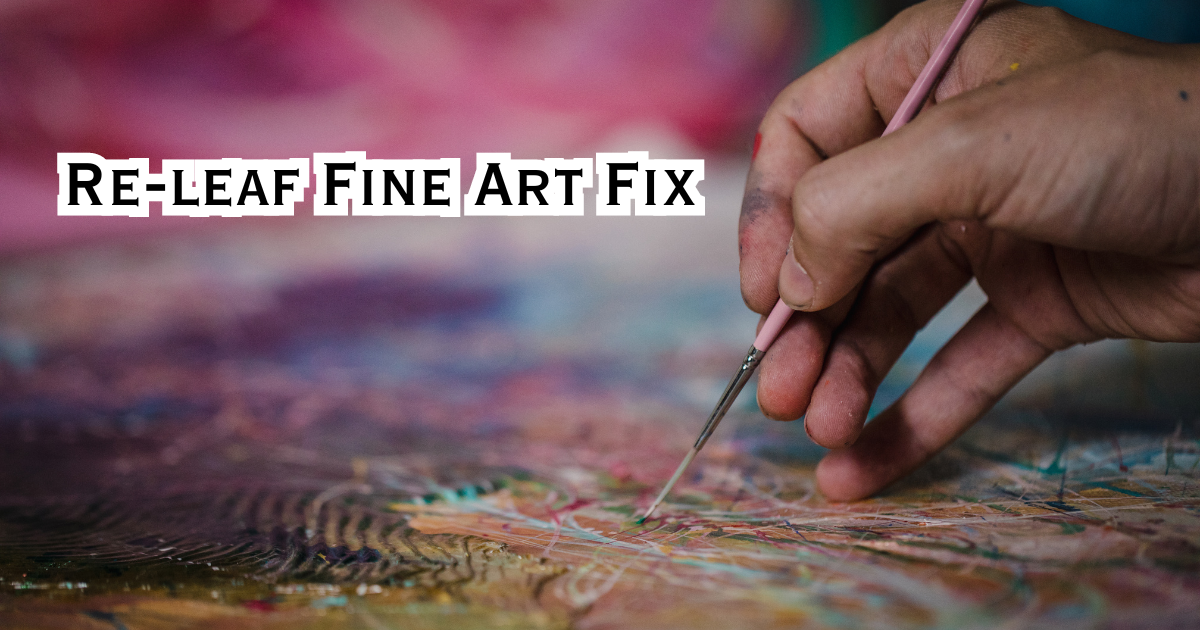Re-leaf Fine Art Fix revitalizes and preserves fine art through specialized techniques. This process demands meticulous attention to detail, ensuring the repair and rejuvenation of artworks without compromising their original essence. The term “re-leaf” symbolizes breathing new life into damaged art pieces, allowing future generations to appreciate them. This method addresses various issues, from tears and cracks to color fading and structural damage. Art collectors, galleries, and museums benefit greatly from this service, as it protects the longevity and aesthetic of their collections.
Why is Re-leaf Fine Art Fix Crucial for Art Preservation?
Fine art faces numerous threats over time, including environmental factors, accidental impacts, and material aging. Re-leaf Fine Art Fix tackles these issues, preventing further deterioration and maintaining the artwork’s value. Without proper restoration and care, valuable art pieces can lose both their visual appeal and cultural significance. This technique plays a crucial role in preserving art’s vibrancy and integrity. By preserving both the aesthetic and historical aspects of art, re-leaf fine art fix safeguards cultural heritage.
Understanding Re-leaf Fine Art Fix
The Concept Behind Re-leaf Fine Art Fix
Re-leaf Fine Art Fix aims to restore art to its original condition while respecting the artist’s vision. The process combines traditional techniques with modern technology, allowing restorers to address different types of damage effectively. The goal focuses on making the repairs seamless and virtually undetectable. This method requires a deep understanding of art history, materials, and techniques, making re-leaf fine art fix a specialized field that demands both skill and knowledge. Whether repairing a canvas tear or retouching faded colors, the re-leaf process ensures that the artwork remains true to its original form.
Types of Fine Art Damage Addressed by Re-leaf Fine Art Fix
Fine art can suffer various types of damage, and re-leaf fine art fix tackles them all. Common issues include tears, punctures, and holes in canvases, often caused by accidents or mishandling. Paintings may also fade, discolor, or crack over time, especially if exposed to sunlight or fluctuating temperatures. Sculptures can experience chipping, cracking, or other structural damage. Re-leaf fine art fix addresses these issues with precision, repairing the damage and preventing further deterioration. This approach provides a comprehensive solution to maintain the integrity of fine art.
The Process of Re-leaf Fine Art Fix
Initial Assessment: Identifying the Need for Re-leaf Fine Art Fix
The re-leaf fine art fix process begins with a thorough assessment of the artwork. This step involves examining the piece for visible damage and identifying any underlying issues that may not be immediately apparent. Restorers look for signs of wear, such as fading, cracking, or tears, as well as any structural issues that could compromise the piece’s integrity. This assessment proves crucial because it allows the restorer to develop a plan that addresses all necessary repairs. The goal focuses on restoring the artwork to its original condition without causing additional damage.
Cleaning and Preparing the Artwork
Before making any repairs, the artwork must be cleaned and prepared. This step proves essential because dirt, dust, and grime can interfere with the restoration process. Cleaning removes these contaminants, allowing the restorer to see the piece’s true condition. Different cleaning methods apply depending on the type of artwork and the materials involved. For example, restorers clean paintings with gentle solvents, while sculptures might require more specialized techniques. Preparing the artwork also involves stabilizing any loose or damaged areas to prevent further deterioration during restoration.
Re-leaf Fine Art Fix Techniques: A Step-by-Step Guide
The re-leaf fine art fix process involves several steps, each designed to address specific types of damage. First, the restorer repairs any tears or holes in the canvas using patches or other materials that match the original. The goal focuses on making the repair as seamless as possible so that it’s virtually invisible. Next, the restorer retouches any faded or discolored areas using carefully matched paints. This step requires a deep understanding of color theory and the ability to blend colors perfectly. Finally, the restorer applies a protective coating to the artwork to prevent future damage. This coating protects the piece from environmental factors like sunlight and humidity.
Re-leaf Fine Art Fix: Repairing Tears and Holes in Paintings
Repairing tears and holes in paintings is one of the most common tasks in the re-leaf fine art fix process. These types of damage often result from accidents, mishandling, or natural wear and tear. The key to repairing these issues involves ensuring that the repair remains as seamless as possible. This process includes using patches or other materials that match the original canvas and carefully blending them into the existing artwork. The goal focuses on making the repair invisible to the naked eye, so the artwork appears as though it was never damaged. This task requires a high level of skill and attention to detail.
Color Matching and Retouching in Re-leaf Fine Art Fix
Color matching and retouching serve as critical components of the re-leaf fine art fix process. When a painting fades or discolors over time, it can lose its original vibrancy and appeal. To restore the artwork, the restorer must carefully match the colors and blend them seamlessly with the existing artwork. This step requires a deep understanding of color theory and the ability to work with different types of paints and pigments. The goal focuses on ensuring that the restored areas remain indistinguishable from the original, preserving the artwork’s integrity.
Re-leaf Fine Art Fix for Sculpture Restoration
Sculpture restoration presents unique challenges that require specialized techniques. Unlike paintings, sculptures are three-dimensional objects that can suffer from various structural issues. Cracks, chips, and broken pieces are common problems that restorers must address with care. The re-leaf fine art fix process for sculptures involves repairing these issues using materials that match the original sculpture. This can include filling in cracks with resin or recreating missing pieces using 3D printing technology. The goal focuses on restoring the sculpture to its original form without compromising its structural integrity.
Benefits of Re-leaf Fine Art Fix
Extending the Lifespan of Art Through Re-leaf Fine Art Fix
One significant benefit of re-leaf fine art fix is its ability to extend the lifespan of artwork. Over time, all art pieces naturally degrade due to environmental factors and aging materials. Re-leaf fine art fix repairs damage and prevents further deterioration, ensuring that the artwork can be enjoyed for generations. In many cases, restored art pieces can last even longer than they would have if left untreated. This preservation method proves invaluable for safeguarding cultural heritage and maintaining the value of fine art.
Enhancing the Aesthetic Appeal with Re-leaf Fine Art Fix
Besides preserving the artwork’s lifespan, re-leaf fine art fix also enhances its aesthetic appeal. Damage such as fading, cracks, and tears can significantly detract from a piece’s visual impact. By addressing these issues, re-leaf fine art fix restores the artwork’s original beauty. This restoration not only makes the piece more enjoyable to look at but also increases its value. Whether a painting has lost its vibrancy or a sculpture has chipped or cracked, re-leaf fine art fix brings the artwork back to life.
Protecting the Investment: The Financial Value of Re-leaf Fine Art Fix
Fine art represents a significant financial investment, and any damage can decrease its value. Re-leaf fine art fix helps protect that investment by restoring the artwork to its original condition. In many cases, a well-executed restoration can even increase the piece’s value. This proves especially true for rare or historically significant works of art. By investing in re-leaf fine art fix, collectors and institutions can ensure that their art remains valuable and marketable. This approach makes the process not only a preservation technique but also a wise financial decision.
Choosing a Professional for Re-leaf Fine Art Fix
Qualities to Look for in a Re-leaf Fine Art Fix Specialist
Choosing the right professional for re-leaf fine art fix proves crucial to ensuring a successful restoration. A qualified specialist should have a strong background in art history and restoration techniques and experience working with different types of artwork. They should provide references and examples of previous work, demonstrating their ability to handle the specific type of restoration your artwork needs. Additionally, a good restorer should remain detail-oriented and patient, as the re-leaf fine art fix process requires precision and care. It’s important to choose a professional who understands the value of your artwork and commits to preserving its integrity.
Re-leaf Fine Art Fix: DIY vs. Professional Services
While some minor repairs can be done at home, re-leaf fine art fix generally belongs in the hands of professionals. Attempting to fix significant damage on your own can result in further harm to the artwork, potentially decreasing its value. Professional restorers possess the tools, materials, and expertise needed to handle complex repairs and ensure that the artwork returns to its original condition. While the temptation to save money by attempting a DIY restoration exists, the risks often outweigh the benefits. Investing in professional re-leaf fine art fix services can save you money in the long run by preventing costly mistakes.
Costs Involved in Re-leaf Fine Art Fix
The cost of re-leaf fine art fix can vary widely depending on the extent of the damage and the complexity of the restoration. Minor repairs, such as fixing small tears or retouching faded areas, may remain relatively affordable. However, more extensive damage, such as large tears or structural issues in sculptures, can require a higher investment. The cost also depends on the materials used and the time required to complete the restoration. It’s important to get an estimate from a qualified restorer before proceeding with the re-leaf fine art fix process so you can budget accordingly.
Case Studies and Examples
Famous Works Restored Through Re-leaf Fine Art Fix
Re-leaf fine art fix has restored many famous works of art, bringing them back to their original glory. For example, well-known paintings by artists like Rembrandt, Van Gogh, and Da Vinci have undergone this process. These works have been carefully restored to address issues such as fading, cracking, and even structural damage. The success of these restorations demonstrates the effectiveness of re-leaf fine art fix in preserving both the aesthetic and historical value of fine art. These case studies highlight the importance of investing in professional restoration services to maintain the integrity of valuable artworks.
Before and After: Visual Impact of Re-leaf Fine Art Fix
One of the most compelling aspects of re-leaf fine art fix involves the dramatic difference it makes in the appearance of a piece. Before and after comparisons often reveal a striking transformation, with the artwork looking as vibrant and intact as it did when first created. This proves especially true for paintings that have suffered from fading or discoloration. The restoration process brings out the original colors and details, making the artwork look fresh and new again. These visual improvements demonstrate the skill and precision involved in re-leaf fine art fix.
Maintaining Art After Re-leaf Fine Art Fix
Post-Restoration Care: How to Maintain Art After Re-leaf Fine Art Fix
After completing the re-leaf fine art fix process, it’s essential to take steps to maintain the artwork and prevent future damage. This includes keeping the artwork in a stable environment with consistent temperature and humidity levels. Protecting the artwork from direct sunlight also proves crucial, as it can cause fading and discoloration over time. Regular cleaning and inspection can help identify any potential issues before they become serious problems. By taking these precautions, you can ensure that your restored artwork remains in excellent condition for years to come.
Future Trends in Re-leaf Fine Art Fix
As technology advances, new methods and materials make the re-leaf fine art fix process even more effective. For example, 3D printing now recreates missing pieces of sculptures with incredible accuracy. Additionally, advancements in paint and pigment technology allow restorers to achieve better color matching and blending. These innovations push the boundaries of what’s possible in art restoration, ensuring that fine art can be preserved and enjoyed for generations to come.
In conclusion, re-leaf fine art fix revitalizes fine art, preserving its beauty and value for years to come. Whether you’re a collector, gallery owner, or simply an art enthusiast, investing in re-leaf fine art fix protects your valuable pieces and ensures they continue to inspire future generations.










